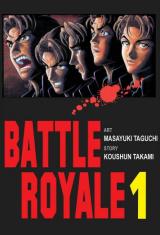Battle Royale contains the usual guro, snuff, blood-spattering, and back-stabbing content that all too many of the more visceral and under/overstimulated fans expect and enjoy, with one notable difference. Had this manga continued in the same vein as most others in its’ category, I would have simply dismissed it and gone on to other things, but the issues it raises are so repugnant that I felt the need to comment on it here for the dubious benefit of those who have not yet read or watched any of the media in this franchise.
Put as simply as possible, Battle Royale involves a moral and ethical subversion in the reader. In more modern scientific terminology, it relies on triggering a cognitive dissonance in the reader to capture your attention. In modern media, you can have good characters committing evil acts (catch 22’s), and evil characters committing good acts (antiheros), along with fallen and redeemed characters switching allegiances back and forth as the plots require. Yet, for the most part, the underlying ethical structure of the universe in the story remains static, and more or less consonant with our own: good is good, and evil is still evil. In Battle Royale, this underlying subtext is carefully mutated throughout the plotline, generating an ego-trip and desensitization in the reader.
Analyzing the story with en eye towards psychological b.s. that a largly waisted college degree left me with; you can easily see the moral subversions leading to the elements designed to trigger a cognitive dissonance: characters whos' actions are clearly evil are treated in the artwork and dialog in a manner that a person familiar with manga would recognize as styles and effects more frequently used to highlight positive actions or emotions. So, too, does the moral and ethical structure of the world represented in the manga deviate horrifically from the norm: presenting a representation of individuals as ‘normal good people’ and ‘normal evil people’, while clearly showing that the society as a whole – composed of the summation of those ‘normal individuals’, is unredeemably sick, sadistic, and debased; with even the ‘best’ members of the society shown accepting without serious debate or question the atrocities around them, provided it doesn’t directly impact them. You end in a situation where you have ‘good’ characters implicitly accepting the sadistic environment that surrounds them as a positive environment. This leads to another ethically-related cognitive dissonance – where in reading the story, one has to visualize and accept the moral structure and environment in which the characters’ decisions are made, to provide the context used in rationalizing those decisions. This is, of course, something the majority of the readers will do without even recognizing it for what it is, leading to the gradual desensitization I referred to earlier.
Frankly, for a disturbingly sizeable number of it’s admirers, the resulting ego-trip of the cognitive dissonance itself is probably the appeal.
I recognize that these opinions will offend many of the people who scored this manga highly, and I apologize – a little. If you read up on the effects of cognitive dissonance (wiki it), you’ll learn that your rejection is fully expected, and perfectly normal – and seriously disturbing. I really do find this kind of psychologically manipulative, shock-value, near-propaganda manga disconcerting, and I really do feel that prospective readers should be aware that there are more serious issues in the manga, detracting from the admittedly good art, and consistent (if warped, debased, degenerate, and offensive) storyline and plot.
Better luck reading a different manga, folks.





